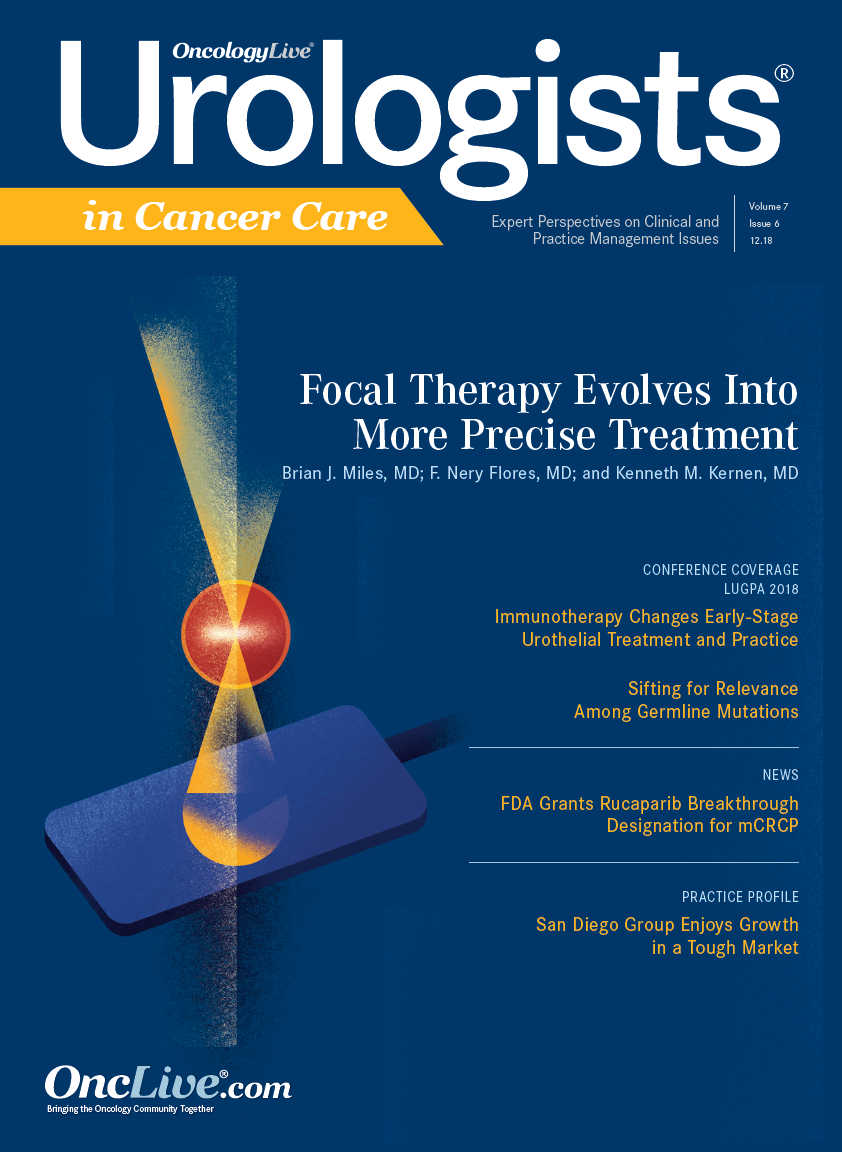Publication
Article
Special Issues
Immunotherapy Changes Early-Stage Urothelial Carcinoma Paradigm
Author(s):
Newer immunotherapy agents are changing traditional strategies for care, resulting in higher levels of collaboration.

Noah M. Hahn, MD
Since 2016, the FDA has approved 5 immune checkpoint inhibitors (ICIs) to treat urologic cancers. Although that is a good thing for patients, the rise of these agents means that the role of the urologist in cancer is changing, Noah M. Hahn, MD, said during the 2018 Large Urology Group Practice Association (LUGPA) Annual Meeting, held November 1-3 in Chicago, Illinois. Newer agents are changing traditional strategies for care, resulting in higher levels of collaboration.
Hahn, director of the medical oncology bladder program at Johns Hopkins School of Medicine, has been working closely with Howard I. Scher, MD, the D. Wayne Calloway Chair in Urologic Oncology at Memorial Sloan Kettering Cancer Center, over the past few years as systemic anticancer therapies have moved from the metastatic setting into earlier stages of urologic disease. “It’s a very exciting time right now in both spectrums: urology and oncology,” Hahn said. “We’re going to be seeing a lot more cross-discipline care.”
The KEYNOTE-045 trial was the first to show an overall survival (OS) advantage over chemotherapy for an ICI in advanced bladder cancer and helped to start this revolution, Hahn said. The trial was stopped early, in 2016, after meeting its primary endpoint of OS. Two-year follow-up data from the phase III trial showed sustained improvements in OS with pembrolizumab (Keytruda) over chemotherapy in pretreated patients with locally advanced or recurrent urothelial cancer.
The median OS was 10.3 months with pembrolizumab versus 7.4 months for chemotherapy (HR, 0.73; 95% CI, 0.59-0.91; P = .002), according to the initial results, published in the New England Journal of Medicine. The 12-month OS rate was 43.9% (95% CI, 37.8%-49.9%) in the pembrolizumab group versus 30.7% (95% CI, 25.0%-36.7%) in the chemotherapy group.1
“What got immunotherapy approved in bladder cancer was the fact that this trial was the first trial to ever show an [OS] advantage versus chemotherapy in patients with advanced disease,” Hahn said. “We had never seen that despite the previous 30 years of trying with various chemotherapies and combinations.”
In KEYNOTE-045, patients with histologically or cytologically confirmed urothelial carcinoma who progressed after 1 to 2 lines of platinum-based chemotherapy were randomly assigned to 200 mg of pembrolizumab every 3 weeks (n = 270) or investigator’s choice of paclitaxel at 175 mg/m2, docetaxel at 75 mg/m2, or vinflunine at 320 mg/m2, each administered every 3 weeks (n = 272).
As assessed by blinded central review, the overall response rate was 21.1% versus 11.4% in favor of the pembrolizumab arm (P = .001). The median duration of response was not reached (range, 1.6-15.6 months) with pembrolizumab compared with 4.3 months (range, 1.4-15.4) with chemotherapy.
“What that trial showed was that immunotherapy with pembrolizumab resulted in about twice as many patients seeing their tumors shrink—about 20% compared with 10%,” Hahn said. “While that’s not a high percentage of patients, if you were in the group that responded, those responses tended to be durable.”
Figure: Early Stage Bladder Cancer is Less Challenging to Treat
Immunotherapy in MIBC and NMIBC
The trial also provided supporting evidence that immunotherapy is generally better tolerated that chemotherapy, Hahn pointed out. In KEYNOTE-045, the incidence of treatment-related adverse events (TRAEs) was lower with pembrolizumab for any grade (60.9% vs 90.2%) and grade 3/5 (15.0% vs 49.4%). The discontinuation rate resulting from TRAEs was 5.6% in the pembrolizumab arm and 11% in the chemotherapy arm.With the success of ICIs in metastatic disease—not just pembrolizumab, but also atezolizumab (Tecentriq), durvalumab (Imfinzi), and others—investigators have sought to determine if these agents can produce better outcomes in patients with earlier-stage bladder cancer, when the disease is less invasive (FIGURE). Several ongoing studies are exploring whether immunotherapy could be effective in patients with muscle invasive or nonmuscle invasive bladder cancer (MIBC/NMIBC).
Investigators are evaluating immunotherapy agents in the adjuvant setting in a pair of phase III trials: IMvigor010 (NCT02450331) is investigating atezolizumab versus observation in high-risk MIBC, and AMBASSADOR (NCT03244384) is investigating pembrolizumab versus observation in locally advanced bladder cancer. In addition, the phase II CheckMate 274 (NCT02632409) is investigating nivolumab (Opdivo) versus placebo in bladder or upper urinary tract cancer following surgery. Results from AMBASSADOR are expected in 2019. The other trials are expected to report in 2020.
Hahn sees much potential for success with early intervention using ICIs. “If we move to the nonmuscle invasive space, this is where I think things get really exciting,” he said. Data from the phase II KEYNOTE- 057 trial showed encouraging antitumor activity with pembrolizumab monotherapy in patients with high-risk NMIBC that is unresponsive to Bacillus Calmette-Guérin who refused or were ineligible for cystectomy. Findings from an interim analysis of the ongoing single-arm, open-label trial were presented at the European Society for Medical Oncology (ESMO) 2018 Congress.2
At a median follow-up of 14.0 months, the rate of complete response (CR) in the first 103 patients enrolled with carcinoma in situ with or without papillary disease was 38.8% (95% CI, 29.4%-48.9%) at 3 months. Eighty percent of patients had a CR lasting 6 months. The median time to CR was 12.4 weeks (95% CI, 10.4-19.3). Twenty-nine (72.5%) responders had ongoing responses, and the median duration of CR had not been reached (range, 0-14.1 months).
“One of the questions that I think we’ll see addressed in follow-up presentations of these data is duration,” Hahn said. “These data are too early to give us insight into that, but they did give us a little bit of a hint of the durability of the CRs.” He noted that that the CR rate at 6 months based on these results would be about 31%, which falls short of the International Bladder Cancer Group’s guideline definition of a clinically meaningful 6-month CR rate for this patient population: 50%.3
At this year’s ESMO Congress, Ronald de Wit, MD, PhD, group leader of the Experimental Systematic Therapy of Urogenital Cancers Program at Erasmus MC Cancer Institute, Rotterdam, The Netherlands, presented KEYNOTE-057 results for 130 patients who received 200 mg of pembrolizumab every 3 weeks. Treatment continued until recurrence of high-risk NMIBC. If NMIBC was present at any assessment, patients discontinued treatment and entered survival follow up. The primary endpoint was a CR, defined as absence of NMIBC.
The interim analysis used an enrollment cutoff to ensure adequate follow up for response evaluation. The database cutoff was July 18, 2018 and the enrollment cutoff was on April 1, 2018.
Most (96.1%) patients had at least 1 adverse event (AE). The rate of grade 3/5 AEs was 26.2% and the rate of grade 3/5 TRAEs was 12.6%. TRAEs in ≥2 patients included pruritus (10.7%), fatigue (9.7%), diarrhea (8.7%), hypothyroidism (5.8%), maculopapular rash (5.8%), arthralgia (4.9%), rash (4.9%), hyperthyroidism (3.9%), and nausea (3.9%). The most common grade 3/5 TRAEs were hyponatremia (2.9%) and arthralgia (1.9%). Immunerelated grade 3/5 TRAEs experienced by 1 patient each were adrenal insufficiency, colitis, hypophysitis, pruritus, rash, and type 1 diabetes.
Urology Practice Must Change to Accommodate Immunotherapy
Hahn noted that the incidence of grade 3/5 TRAEs in KEYNOTE-057 was similar to what had been previously observed in the metastatic setting. Of 3 deaths in the study, only 1, attributed to autoimmune colitis, was related to treatment. “That’s about what we see in all diseases,” Hahn said. “It’s about a 1% or less autoimmune-related potentially fatal event, and that’s something that has been consistent throughout.”Immunotherapy is still a relatively new phenomenon in the urology world, but its success has been clear. Hahn noted that trial participants have been followed only for 3 to 4 years, but “are alive longer than we have ever seen before.”
However, when considering whether it is possible or practical to use immuno-oncology agents in early stages of disease, Hahn said practice concerns need to be kept in mind. Use of these agents will require a major education component for urologists generally and for oncologists who are unfamiliar with NMIBC. Further, urology practices will have to think about infusion center and toxicity management infrastructure, their relationships with practitioners in other specialties, and the in-house commitment to this treatment modality.
“How does your group feel about systemic therapy?” he said. “ It’s one thing to have a champion who wants to do it and is going to take on doing it for their patients, but who’s going to take the call on Friday at 4:30 PM. when you’re out on vacation? Those things need to be talked about.”
References
- Bellmunt J, De Wit R, Vaughn DJ, et al; KEYNOTE-045 Investigators Pembrolizumab as second-line therapy for advanced urothelial carcinoma. N Engl J Med. 2017;376(11):1015-1026. doi: 10.1056/NEJMoa1613683
- de Wit R, Kalkami GS, Uchio E, et al. Pembrolizumab for high-risk (HR) non—muscle invasive bladder cancer (NMIBC) unresponsive to bacillus calmette-guérin (BCG): phase 2 KEYNOTE-057 Trial. In: Proceedings from the 2018 ESMO Congress; October 19-23, 2018; Munich, Germany. Abstract 8640. academic.oup.com/annonc/article/29/suppl_8/ mdy283.073/5140263?searchresult=1.
- Kamat AM, Sylvester RJ, Böhle A, et al. Definitions, end points, and clinical trial designs for non-muscle-invasive bladder cancer: recommendations from the International Bladder Cancer Group. J Clin Oncol. 2016;34(16):1935-1944. doi: 10.1200/JCO.2015.64.4070.






















%20(2)%201-Recovered-Recovered-Recovered-Recovered-Recovered-Recovered-Recovered-Recovered-Recovered-Recovered-Recovered-Recovered-Recovered-Recovered-Recovered-Recovered-Recovered.jpg?fit=crop&auto=format)
%20(2)%201-Recovered-Recovered-Recovered-Recovered-Recovered-Recovered-Recovered-Recovered-Recovered-Recovered-Recovered-Recovered-Recovered-Recovered-Recovered-Recovered-Recovered.jpg?fit=crop&auto=format)
